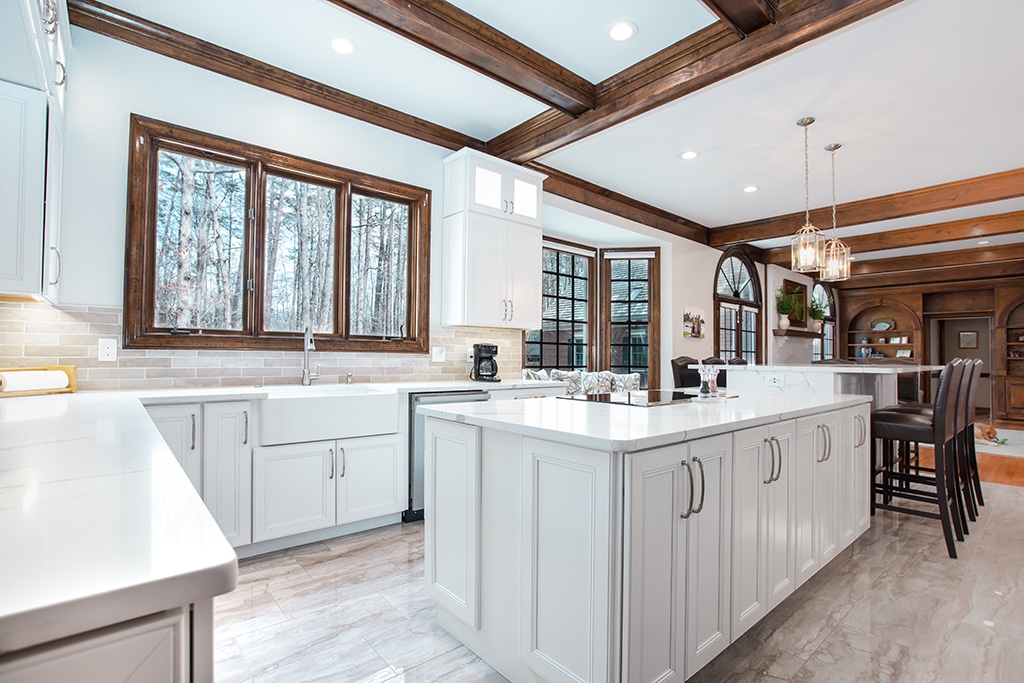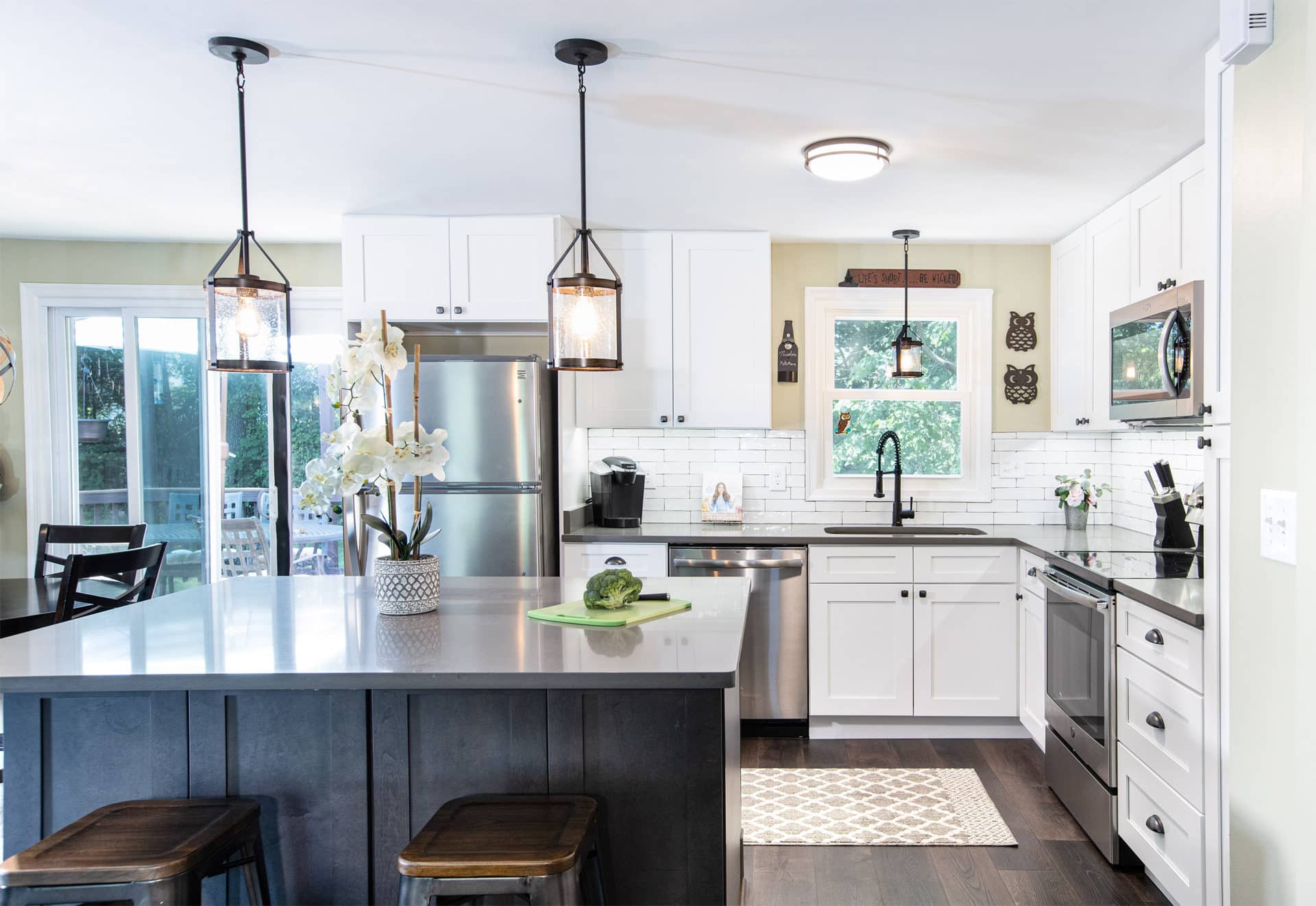When it comes to modern kitchen layouts, the large kitchen island stands as a centerpiece, blending functionality with aesthetics. They’ve evolved from simple prep areas to multipurpose spaces, suitable for cooking, dining, and storage. Let’s delve into the expansive world of oversized kitchen island designs and uncover the true potential of this kitchen staple.

Why Consider a Large Kitchen Island?
Considering a large kitchen island is a wise choice for several reasons. Firstly, in bigger kitchens, a sizable island not only serves as a striking centerpiece but also introduces more workspace, maximizing both space and functionality. Secondly, such islands offer versatile seating arrangements. Imagine having an island spacious enough to accommodate over six seats; it effortlessly transforms into an informal dining area, a dedicated spot for kids to do their homework, or a cozy corner for your morning coffee rituals. Lastly, the advantage of enhanced storage can’t be overlooked. With built-in cabinets, shelves, and drawers, a large kitchen island provides innovative storage solutions that keep your kitchen essentials organized and within reach.
Diverse Designs for Every Kitchen
Classic wooden designs in kitchen islands are known for their warmth and timeless allure. These islands often feature bespoke elements such as built-in wine racks or bookshelves, infusing both beauty and function into the space. On the other hand, modern minimalist islands are the epitome of contemporary elegance. Characterized by sleek lines, shiny surfaces, and subdued colors, they’re typically accompanied by subtle, handleless cabinets to maintain a seamless appearance. Meanwhile, for those who adore a touch of nostalgia, rustic farmhouse islands are an ideal choice. With distinct features like barn doors and weathered finishes, they radiate a comforting and homely charm that’s both inviting and stylish.

Custom Features to Elevate Your Island
Custom kitchen island features can make your space uniquely yours:
- Pop-up Electrical Outlets: Perfect for plugging in appliances without trailing cords.
- Integrated Appliances: Imagine a wine fridge or microwave drawer tucked neatly into your island.
- Pull-out Storage: Baskets or spice racks can be discreetly concealed yet easily accessible.
The Pros and Cons of a Large Kitchen Island
Pros:
- Additional Workspace: One of the most obvious benefits. It offers an expansive countertop area, ideal for meal prep, baking, or even hosting buffet-style meals.
- Versatile Seating: As mentioned, a kitchen island with seating for 6+ becomes a multifunctional space. It can serve as an informal dining area, a workspace, or even a bar during gatherings.
- Enhanced Storage Solutions: Islands can come packed with drawers, shelves, and cabinets. These kitchen island storage solutions can hide away pots, pans, and even smaller appliances.
- Aesthetic Appeal: A well-designed island can elevate the overall look of the kitchen. Custom kitchen island features can be added for a tailored look.
- Increased Property Value: A functional and stylish kitchen island can be a strong selling point if you ever decide to sell your home.
Cons:
- Space Consumption: Not all kitchens can accommodate a large island. It can sometimes make the area feel cramped, obstructing the flow of traffic.
- Higher Costs: Bigger islands, especially those with custom features, can be expensive. Both in terms of initial costs and potential maintenance.
- Potential for Clutter: With more surface area, there’s a temptation to leave items out or to use the space as a dumping ground for miscellaneous objects.
- Complex Installation: If you’re integrating appliances or sinks into the island, installation becomes more complicated, often requiring plumbing or electrical work.
- Cleaning Challenges: A larger surface area means more to clean. Plus, depending on the material, there may be maintenance tasks to keep the island looking its best.

Best Materials for a Large Kitchen Island
When designing a large kitchen island, material choice plays a pivotal role in determining both the functionality and aesthetic appeal of the island. Here’s a breakdown of popular materials, with their distinct features and benefits:
Granite:
- Pros: Granite is durable and resistant to heat, and each slab possesses unique veining, making every island one-of-a-kind.
- Cons: It can be expensive and requires sealing to prevent staining.
Quartz:
- Pros: Quartz countertops are non-porous (reducing bacterial growth), offer consistent coloration, and are resistant to staining.
- Cons: They can be pricey and aren’t as heat-resistant as granite.
Wood (Butcher Block):
- Pros: Wood adds warmth and a natural element to the kitchen. It’s ideal for food prep and can be sanded and refinished.
- Cons: It requires regular maintenance (oil application) and can be susceptible to scratches and water damage.
Concrete:
- Pros: Concrete offers an industrial look, is heat resistant, and can be custom tinted.
- Cons: It’s porous, so sealing is essential. Over time, it might develop hairline cracks.
Stainless Steel:
- Pros: This gives a sleek, modern look and offers a non-porous, hygienic surface that’s easy to clean.
- Cons: It can scratch easily and might not suit all kitchen aesthetics.
Marble:
- Pros: Marble exudes luxury and elegance, and like granite, every slab is unique.
- Cons: It’s porous, making it susceptible to stains from acidic substances. Regular sealing is a must.
Soapstone:
- Pros: Soapstone is dense and impervious to heat. Over time, it darkens, giving a beautiful patina.
- Cons: It can scratch, but these can be sanded out. It might require mineral oil applications to maintain its appearance.
Porcelain:
- Pros: It’s non-porous, resistant to scratching, and can mimic the appearance of other materials.
- Cons: The edges of porcelain can chip, and while it’s generally durable, a heavy impact might crack it.

Making the Most of Your Large Kitchen Island
Maximizing the utility of your spacious kitchen island is essential. Start by planning its layout with careful thought, keeping workflow in mind. Then, make it a routine to declutter, ensuring that only the crucial items sit on the countertop. Additionally, think about integrating both open shelving and closed cabinets. This blend can provide the best storage solutions and keep your island organized and efficient.
Conclusion
A large kitchen island is more than just a design statement; it’s a testament to a kitchen’s adaptability and functionality. Whether you’re drawn to a minimalist design or crave custom features, there’s a perfect island waiting for you. All it requires is a dash of inspiration and a sprinkle of creativity.
FAQs on Large Kitchen Islands:
What materials are best for a large kitchen island?
Depending on the design, wood, quartz, granite, or even concrete can be ideal, offering both durability and aesthetic appeal.
How do I ensure my kitchen island fits seamlessly into my space?
Measure your kitchen thoroughly and consult with designers. Incorporate cohesive color schemes and similar materials to existing cabinetry.
Can I install a sink or stove on my large kitchen island?
Absolutely! With the right plumbing and electrical setups, your island can house either, boosting its functionality.